engine Oldsmobile Achieva 1998 s Manual Online
[x] Cancel search | Manufacturer: OLDSMOBILE, Model Year: 1998, Model line: Achieva, Model: Oldsmobile Achieva 1998Pages: 356, PDF Size: 18.04 MB
Page 255 of 356

NOTICE:
0
0 0
0
When using concentrated washer fluid,
follow the manufacturer’s instructions for
adding water.
Don’t
mix water with ready-to-use washer
fluid. Water can cause the solution to freeze
and damage your washer fluid tank and
other parts of the washer system. Also,
water doesn’t clean as well as washer fluid.
Fill your washer fluid tank only
three-quarters full when it’s very cold. This
allows for expansion if freezing occurs,
which could damage the tank
if it is
completely full.
Don’t use engine coolant (antifreeze) in
your windshield washer.
It can damage
your washer system and paint.
Brakes
Brake Fluid
Your brake master cylinder reservoir is here. It is filled
with
DOT-3 brake fluid.
6-27
Page 256 of 356
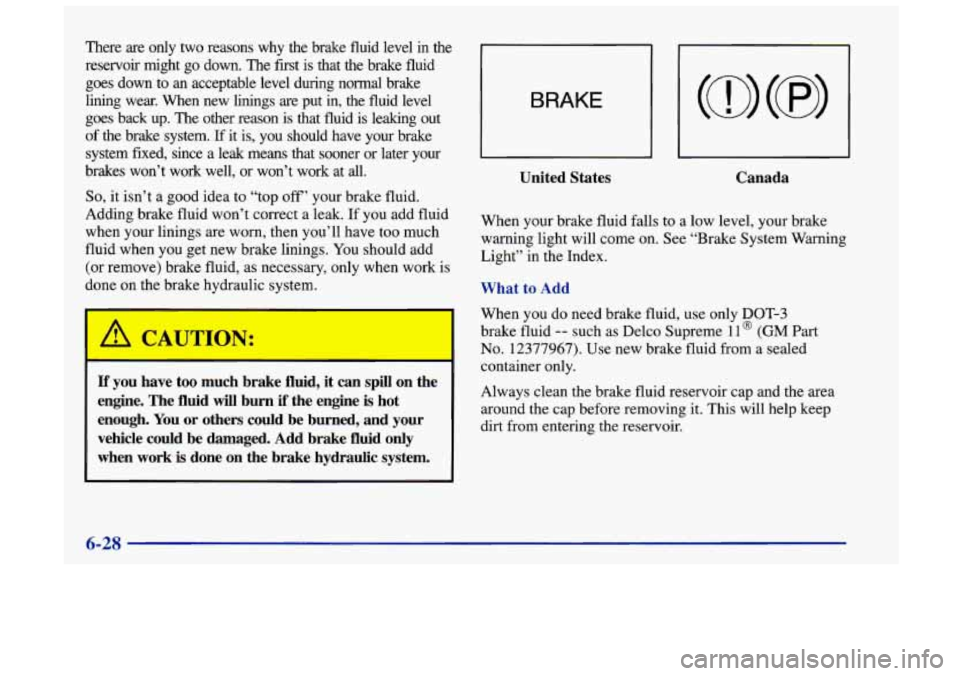
There are only two reasons why the brake fluid level in the
reservoir might go down. The first is that
the brake fluid
goes down to
an acceptable level during normal brake
lining wear. When new
linings are put in, the fluid level
goes back up. The other reason is that fluid is leaking out
of the brake system.
If it is, you should have your brake
system fxed, since
a leak means that sooner or later your
brakes won’t work well, or won’t work at all.
So, it isn’t a good idea to “top off’ your brake fluid.
Adding brake fluid won’t correct a leak. If you add fluid
when your linings are worn, then you’ll have too much
fluid when you get new brake linings. You should add
(or remove) brake fluid, as necessary, only when work is
done on the brake hydraulic system.
If you have too much brake fluid, it can spill on the
engine. The fluid will burn
if the engine is hot
enough.
You or others could be burned, and your
vehicle could be damaged. Add brake
fluid only
when work
is done on the brake hydraulic system.
I
BRAKE
I
United States Canada
When your brake fluid falls to a low level, your brake
warning light will come on. See “Brake System Warning
Light”
in the Index.
What to Add
When you do need brake fluid, use only DOT-3
brake fluid
-- such as Delco Supreme 11 @ (GM Part
No. 12377967). Use new brake fluid from a sealed
container only.
Always clean the brake fluid reservoir cap and the area
around the cap before removing it. This will help keep
dirt from entering the reservoir.
6-28
Page 257 of 356
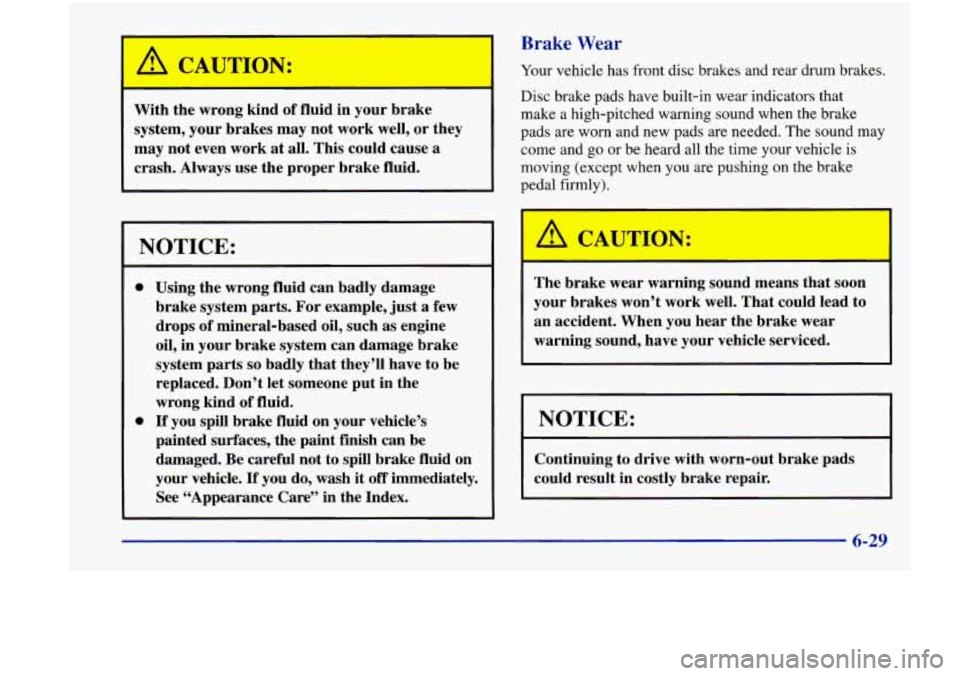
Brake Wear
I A CAUTION:
With the wrong kind of fluid in your brake
system, your brakes may not work well, or they
may not even work
at all. This could cause a
crash. Always use the proper brake fluid.
NOTICE:
Your vehicle has front disc brakes and rear drum brakes.
Disc brake pads have built-in wear indicators that
make a high-pitched warning sound when the brake
pads are worn and new pads are needed. The sound
may
come and go or be heard all the time your vehicle is
moving (except when
you are pushing on the brake
pedal firmly).
0
0 Using the wrong fluid can badly damage
brake system parts. For example,
just a few
drops of mineral-based oil, such
as engine
oil, in your brake system can damage brake
system parts
so badly that they’ll have to be
replaced. Don’t let someone put in the
wrong kind
of fluid.
If you spill brake fluid on your vehicle’s
painted surfaces, the paint finish can be
damaged. Be careful not to spill brake fluid on
your vehicle.
If you do, wash it off immediately.
See “Appearance Care” in the Index. The
brake wear warning sound means that soon
your brakes won’t work well. That could lead to
an accident. When you hear the brake wear
warning sound, have your vehicle serviced.
I NOTICE:
Continuing to drive with worn-out brake pads
could result in costly brake repair.
6-29
Page 280 of 356

Vehicle Identification Number (VIN)
ENGINE/ 1998 T ASSEMBLY
CODE MODEL YEAR PLANT
This is the legal identifier for your vehicle. It appears
on a plate in the front corner of the instrument panel, on
the driver’s side. You can see it if you look through the
windshield from outside your vehicle. The
VIN also
appears on the Vehicle Certification and Service Parts
labels and
the certificates of title and registration.
Engine Identification
The 8th character in your VIN is the engine code. This
code will help you identify your engine, specifications
and replacement parts.
Service Parts Identification Label
You’ll find this label on the bottom of your spare tire
cover. It’s very helpful
if you ever need to order parts.
On this label is:
your VIN,
0 the model designation,
0 paint information and
a list of all production options and
Be sure that this label is not removed from the vehicle.
special equipment.
Electrical System
Add-on
Electrical Equipment
I NOTICE:
Don’t add anything electrical to your vehicle
unless you check with your retailer first. Some
electrical equipment can damage your vehicle
and the damage wouldn’t be covered by your
warranty. Some add-on electrical equipment
can keep other components from working as
they should.
Your vehicle has an air bag system. Before attempting to
add anything electrical
to your vehicle, see “Servicing
Your Air Bag-Equipped Vehicle” in the Index.
6-52
Page 281 of 356
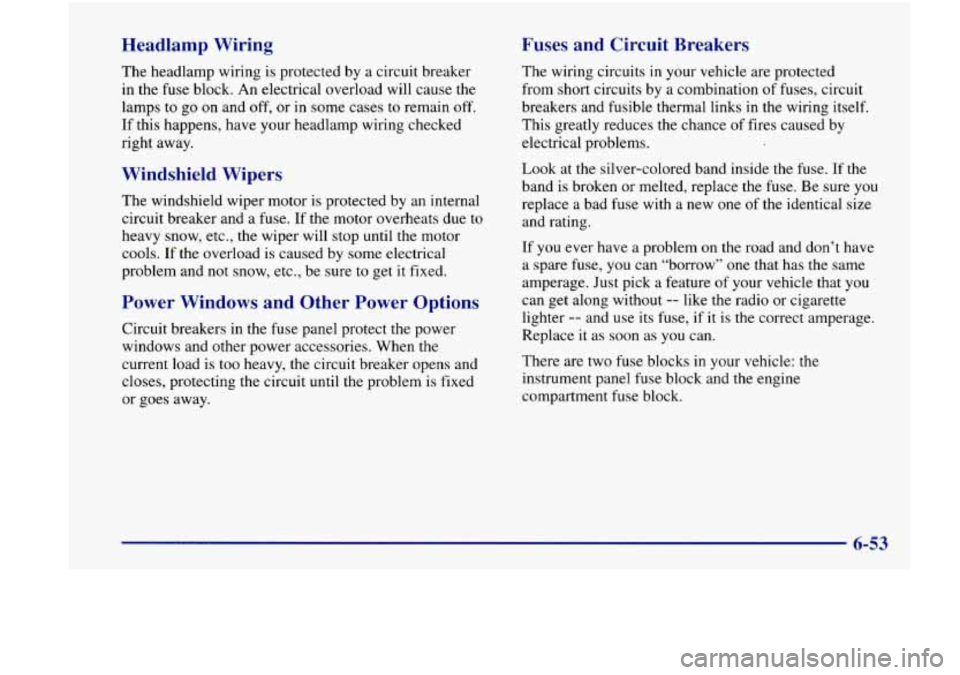
Headlamp Wiring Fuses and Circuit Breakers
The
headlamp wiring is protected by a circuit breaker
in the fuse block. An electrical overload will cause the
lamps to go on and off, or in some cases to remain off.
If this happens, have your headlamp wiring checked
right away.
Windshield Wipers
The windshield wiper motor is protected by an internal
circuit breaker and a
fuse. If the motor overheats due to
heavy snow, etc., the wiper will stop until the motor
cools.
If the overload is caused by some electrical
problem and not snow, etc., be sure to get it fixed.
Power Windows and Other Power Options
Circuit breakers in the fuse panel protect the power
windows and other power accessories. When the
current load is too heavy, the circuit breaker opens and
closes, protecting the circuit until the problem is fixed
or goes away. The
wiring circuits in your vehicle are protected
from short circuits by a combination of fuses, circuit
breakers and fusible thermal links in the wiring itself.
This greatly reduces the chance
of fires caused by
electrical problems.
Look at the silver-colored band inside the fuse. If the
band is broken
or melted, replace the fuse. Be sure you
replace a bad fuse with a new one
of the identical size
and rating.
If you ever have a problem on the road and don’t have
a spare fuse,
you can “borrow” one that has the same
amperage. Just pick a feature of your vehicle that
you
can get along without -- like the radio or cigarette
lighter
-- and use its fuse, if it is the correct amperage.
Replace it as soon as you can.
There are two fuse blocks in your vehicle: the
instrument panel fuse block and the engine
compartment fuse block.
Page 284 of 356
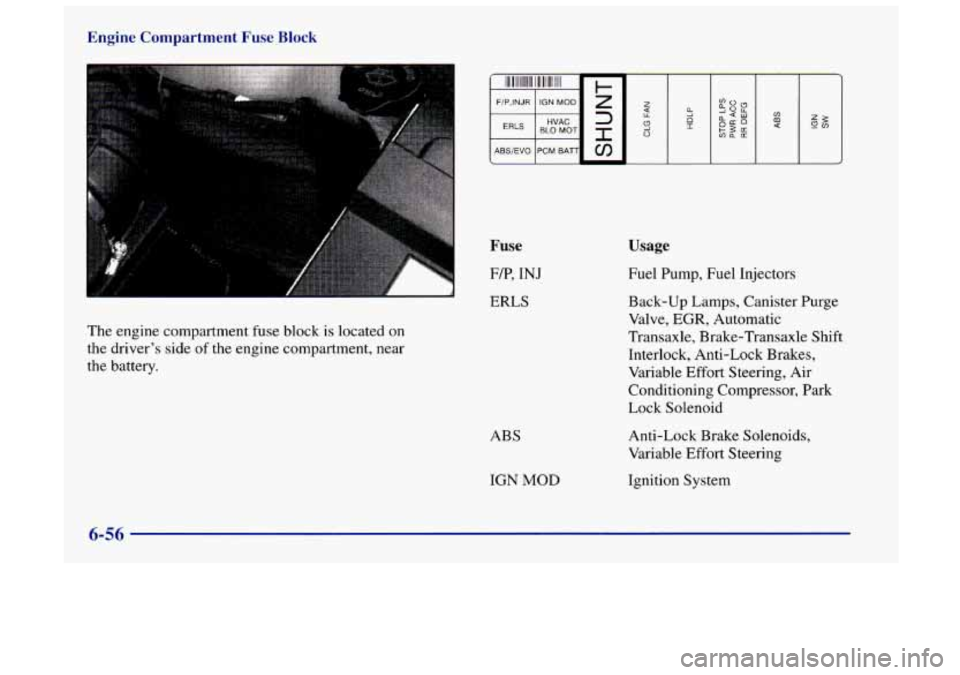
Engine Compartment Fuse Block
I
Fuse
FP,
INJ
ERLS
The engine compartment fuse block
is located on
the driver’s side of the engine compartment, near
the battery.
ABS
IGN
MOD
Usage
Fuel Pump, Fuel Injectors
Back-up Lamps, Canister Purge
Valve,
EGR, Automatic
Transaxle, Brake-Transaxle Shift
Interlock, Anti-Lock Brakes,
Variable
Effort Steering, Air
Conditioning Compressor, Park
Lock Solenoid
Anti-Lock Brake Solenoids,
Variable
Effort Steering
Ignition System
6-56
Page 285 of 356
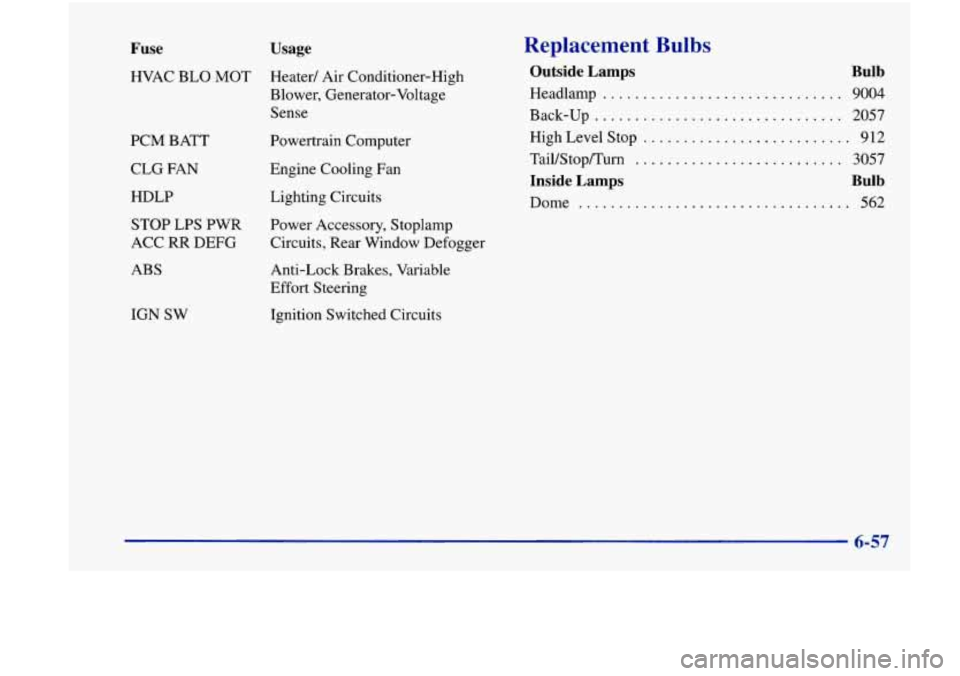
Fuse Usage
HVAC BLO MOT Heater/ Air Conditioner-High
Blower, Generator-Voltage
Sense
PCM BATT
CLG
FAN
HDLP STOP LPS PWR
ACC
RR DEFG
ABS
IGN SW Powertrain Computer
Engine Cooling Fan
Lighting Circuits
Power
Accessory, Stoplamp
Circuits, Rear Window Defogger
Anti-Lock Brakes, Variable
Effort Steering
Ignition Switched Circuits
Replacement Bulbs
Outside Lamps Bulb
Headlamp .............................. 9004
Back-up
............................... 2057
High Level Stop .......................... 912
Tail/Stop/Turn
.......................... 3057
Inside Lamps Bulb
Dome .................................. 562
Page 286 of 356
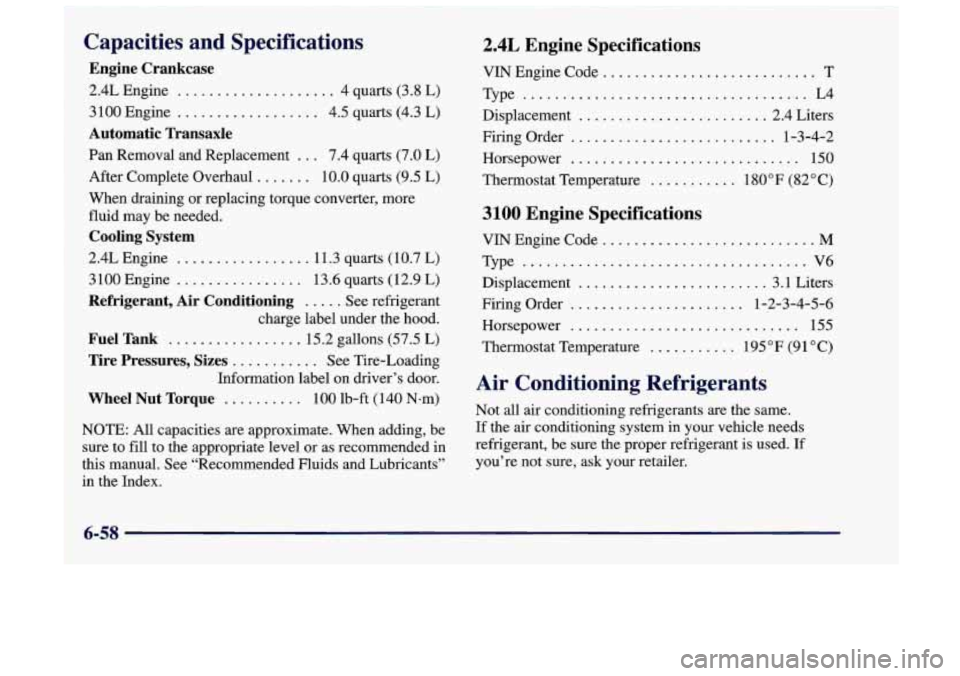
Capacities and Specifications
Engine Crankcase
2.4L Engine .................... 4 quarts (3.8 L)
3 100 Engine .................. 4.5 quarts (4.3 L)
Automatic Transaxle
Pan Removal and Replacement ... 7.4 quarts (7.0 L)
After Complete Overhaul
....... 10.0 quarts (9.5 L)
When draining or replacing torque converter, more
fluid may be needed.
Cooling System
2.4L Engine ................. 11.3 quarts (10.7 L)
3100 Engine
................ 13.6 quarts (12.9 L)
Refrigerant, Air Conditioning ..... See refrigerant
charge label under the hood.
Fuel Tank ................. 15.2 gallons (57.5 L)
Tire Pressures, Sizes ........... See Tire-Loading
Information label on driver’s door.
Wheel Nut Torque .......... 100 lb-ft (140 N-m)
NOTE: All capacities are approximate. When adding, be
sure to fill to the appropriate level or as recommended
in
this manual. See “Recommended Fluids and Lubricants”
’ in the Index.
2.4L Engine Specifications
VIN Engine Code ........................... T
Type
.................................... L4
Displacement
........................ 2.4 Liters
Firing Order
.......................... 1-3-4-2
Horsepower
............................. 150
Thermostat Temperature
........... 1 80” F (82 O C)
3100 Engine Specifications
VIN Engine Code ........................... M
Type .................................... V6
Displacement ........................ 3.1 Liters
Firing Order
...................... 1-2-3-4-5-6
Thermostat Temperature
........... 195 O F (9 1 O C)
Horsepower
............................. 155
Air Conditioning Refrigerants
Not
all air conditioning refrigerants are the same.
If the air conditioning system in your vehicle needs
refrigerant, be sure the proper refrigerant is used.
If
you’re not sure, ask your retailer.
Page 287 of 356
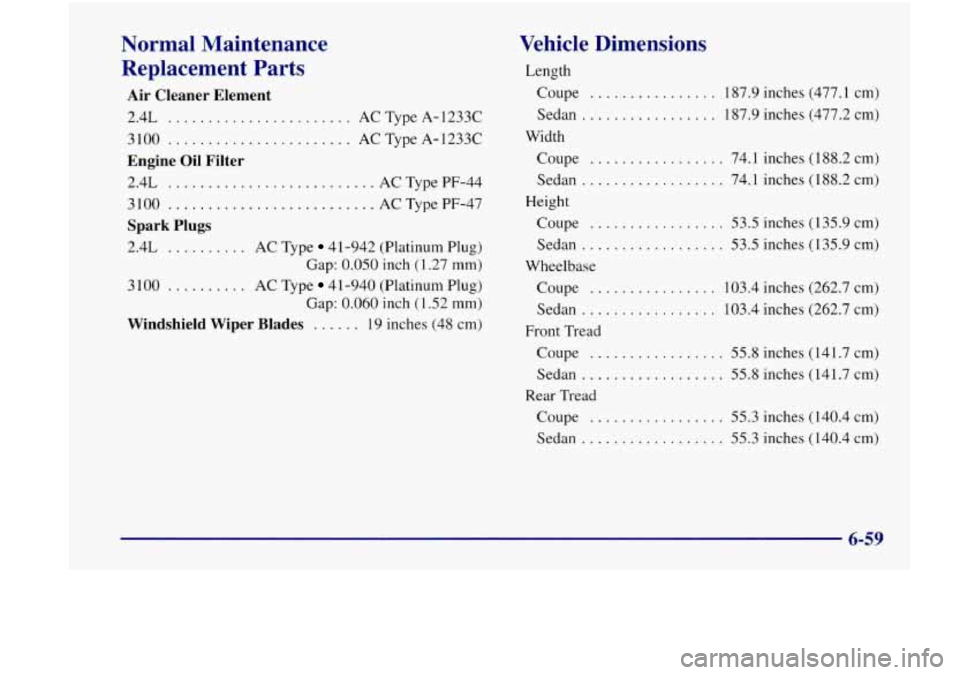
Normal Maintenance Replacement Parts
Air Cleaner Element
2.4L ....................... AC Type A-1233C
3100
....................... ACTypeA-1233C
Engine Oil Filter
2.4L .......................... AC Type PF-44
3100
.......................... ACTypePF-47
Spark Plugs
2.4L .......... AC Type 41 -942 (Platinum Plug)
Gap:
0.050 inch (1.27 mm)
3100
.......... AC Type 41-940 (Platinum Plug)
Gap: 0.060 inch (1.52 mm)
Windshield Wiper Blades ...... 19 inches (48 cm)
Vehicle Dimensions
Length
Coupe
................ 187.9 inches (477.1 cm)
Sedan
................. 187.9 inches (477.2 cm)
Width Coupe
................. 74.1 inches (188.2 cm)
Sedan
.................. 74.1 inches (1 88.2 cm)
Height Coupe
................. 53.5 inches (135.9 cm)
Sedan
.................. 53.5 inches (135.9 cm)
Wheelbase Coupe
................ 103.4 inches (262.7 cm)
Sedan
................. 103.4 inches (262.7 cm)
Front Tread
Coupe
................. 55.8 inches (141.7 cm)
Sedan
.................. 55.8 inches (141.7 cm)
Rear Tread Coupe
................. 55.3 inches (140.4 cm)
Sedan
.................. 55.3 inches (140.4 cm)
6-59
Page 292 of 356
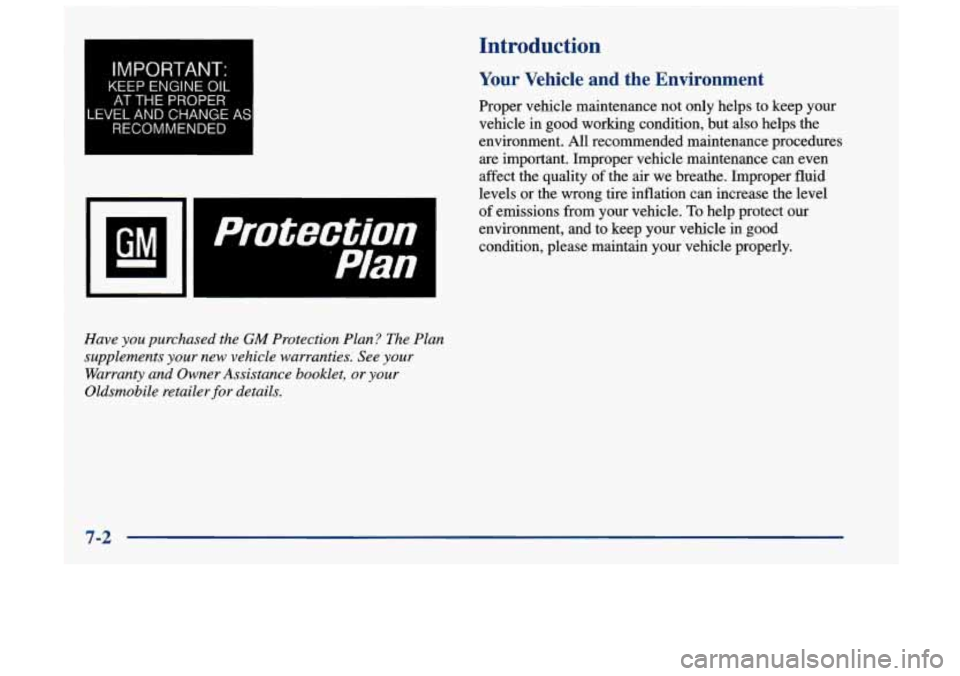
I M PORTANT:
KEEP ENGINE OIL
AT THE PROPER
LEVEL AND CHANGE AS RECOMMENDED
Have you purchased the GM Protection Plan? The Plan
supplements your new vehicle warranties. See your
Warranty and Owner Assistance booklet, or your
Oldsmobile retailer for details.
Introduction
Your Vehicle and the Environment
Proper vehicle maintenance not only helps to keep your
vehicle in good working condition, but
also helps the
environment. All recommended maintenance procedures
are important. Improper vehicle maintenance can even
affect the quality
of the air we breathe. Improper fluid
levels or the wrong tire inflation can increase the level
of emissions from your vehicle.
To help protect our
environment, and to keep your vehicle in good
condition, please maintain your vehicle properly.
7-2